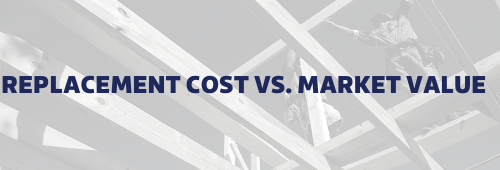What is Replacement Cost vs the Market Value of My Home?
When reviewing homeowners insurance quotes, a lot of clients will question why their house is insured (Coverage A) for more than what they purchased it for or think that it is worth.
.png)
Most insureds would expect this number to match the Market Value or purchase price of their home, but it is important that this figure be set at an appropriate Replacement Cost value. It is important to understand the differences in these figures and how they can affect you in the event of a claim.
Let's break it down for you:
What is “Market Value”?
Market value is the most probable price that a property should bring in a competitive and open real estate market.
What is “Replacement Cost” or RC?
The term “replacement cost” is defined or explained in the insurance policy. Simply stated, it means the cost to replace the property on the same premises with other property of comparable material and quality used
What is “Actual Cash Value” or ACV?
So why wouldn’t I want actual cash value over replacement cost? The major difference between replacement cost and actual cash value is a deduction for depreciation. When a home is insured on ACV, an adjuster will depreciate any complete or partial loss and you will not be in the same position you were in before.
It is important to know what limit you have on your policy so that you don’t find yourself upset during a claim scenario. A few other items to review on your insurance policy when it comes to replacement cost and other factors include:
- Roof Replacement Cost: Review your policy to see if it covers your roof at replacement cost or actual cash value. Some insurance companies will only insure your roof for actual cash value based on the age of your roof and other factors.
- Endorsements increasing your dwelling coverage: Other names for this include Extended Dwelling coverage, Increase Replacement Cost on Dwelling, Extended Replacement Cost Endorsement or Coverage. Insurance companies that add these endorsements expect and may require your home to be insured for its full replacement cost. Ask your agent or read the fine print in the policy to make sure you are following the requirements with the endorsements so they are there when you need them.
- Replacement cost includes more than the cost to rebuild the structure of your home. The replacement cost includes: flooring, your exterior features such as patios, decks, interior features including bathroom and kitchen fixtures, appliances, cabinets, and all the details that make your home unique.
- Deductibles – Make sure to review your deductible to avoid any surprises. In some cases, a carrier may have a property deductible and a separate wind/hail deductible. The wind/hail deductible will typically be higher than your property deductible and can result in a poor claim experience. Another important thing to watch for is deductibles that utilize a percentage instead of a flat amount. A 2% deductible on a $250,000 home would be $5,000. At TROXELL, we promote fixed deductible limits between $1,000 and $2,500 depending on the client’s preference.
Understand your homeowner’s insurance policy and how replacement cost insurance works.
Contact a TROXELL agent today to get a free, no-obligation insurance quote.
See our Homeowners Insurance Services
You may also be interested in these blog posts:
This article was written by:
Ryan Augustine, CIC, CLCS
.jpg) RYAN AUGUSTINE IS AN ACCOUNT EXECUTIVE AT TROXELL. HE WORKS BOTH ON PERSONAL LINES AND COMMERCIAL LINES TO HELP NEW AND EXISTING CLIENTS. RYAN HAS EARNED HIS CERTIFIED INSURANCE COUNSELOR AND COMMERCIAL LINES COVERAGE SPECIALIST DESIGNATIONS.
RYAN AUGUSTINE IS AN ACCOUNT EXECUTIVE AT TROXELL. HE WORKS BOTH ON PERSONAL LINES AND COMMERCIAL LINES TO HELP NEW AND EXISTING CLIENTS. RYAN HAS EARNED HIS CERTIFIED INSURANCE COUNSELOR AND COMMERCIAL LINES COVERAGE SPECIALIST DESIGNATIONS.